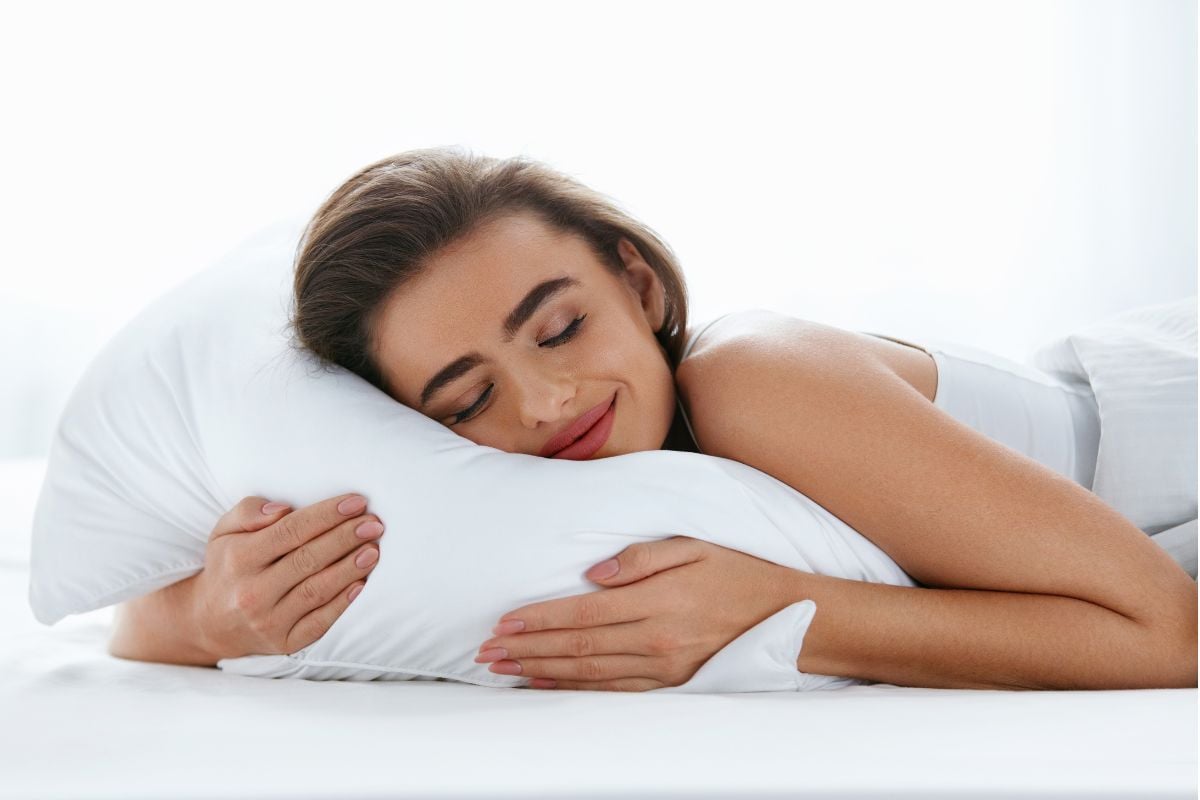The Most Comfortable Organic Pillow For You

Have you ever wondered what is in the pillow that you come in close contact with every night? Today you are going to learn what typical pillows consist of. You’ll also read about how to find a truly organic pillow. Hint: To have confidence that your pillow is truly organic, you need to look for a certified organic pillow as an entire product, not just the pillow cover. And most importantly, we will talk about comfort because even if the healthiest pillow is not comfortable, it does not do you any good. Comfort is crucial when it comes to bedding and a good night’s sleep.
Most Comfortable Organic Pillow
I used to pay no attention to ingredients. Until I had a baby. I realized that it was up to us, consumers, to protect ourselves from numerous substances in products we use on our bodies or homes. They may have a negative impact on our health without our realization. Those effects can manifest themselves in an immediate reaction such as irritation or swelling. They can also happen over a long period of time.
As for pillows, the materials used in conventional pillows I would avoid include:
- memory foam
- polyester, and
- down.
Conversely, there exist natural and organic materials for nontoxic pillows, such as:
- natural latex foam
- wool
- cotton
- kapok
- PLA, and
- buckwheat.
Let’s discuss these materials.

Memory Foam Non-Organic Pillows
If you do not own an organic pillow, your pillow is most likely made of memory foam. Memory foam is also called “polyurethane foam.” I believe that it is the most toxic material for a pillow. The workers who make polyurethane foam must wear full-body protective gear and respirators. According to independent studies, the foam continues to emit toxic gases when you bring it home. You can read more about the potential harms of polyurethane foam to your health and the environment in my post devoted to polyurethane foam.
In addition, researchers at Duke University found that polyurethane foam pillows may contain flame retardant chemicals, including fiberglass, (even though there is no law requiring manufacturers to use them in pillows).
According to the US National Institute of Environmental Health Sciences, adverse health effects of flame retardants may include endocrine and thyroid disruption, immunotoxicity, reproductive toxicity, cancer, and adverse effects on fetal and child development and neurobehavioral function (source).
Also, the NIEHS adds flame retardants to a class of obesogens – chemicals that disrupt metabolism (source). In other words, these chemicals prevent you from losing weight even if you eat a healthy diet and exercise regularly. (You can learn more about flame retardants in my post Are Organic Mattresses Worth It?.)
These are all good reasons to look for an organic pillow, aren’t they?
Polyester Pillows
The good thing is that polyester foam is not known to contain added flame retardants. Hence, on the one hand, polyester is a step forward because polyester pillows are non-flame-retardant pillows.
On the other hand, however, polyester is normally derived from petroleum, and manufacturers do not disclose possible contaminants in it.
Down Pillows
As far as down is concerned, in my experience, with the exception of 3 companies I know, down comes from birds from China. They are grown specifically for down and even plucked live. Absolutely unacceptable. Plus, to sanitize feathers, carcinogenic formaldehyde can be used. So, at the very least, avoid down from China.
If you are like me, you can become allergic to down. If you wake up with red and swollen eyes, your down pillow can be at fault. That happened to me. Thus, it is hard to call a down pillow a nontoxic pillow.

Natural Latex Pillows
Overall, there are two types of natural latex foam: Dunlop and Talalay. Due to their manufacturing process, they differ in their properties. Thus, Dunlop latex is denser and firmer while Talalay latex is often softer and has a plush feel to it due to its porous structure.
When it comes to organic mattresses, the choice of latex foam depends a lot on the buyers’ sleep positions. Thus, side sleepers may prefer Talalay latex due to its softness, and back and stomach sleepers may choose Dunlop for its firmness to maintain proper alignment and support.
You can choose your latex pillow based on these characteristics, too, as well as on the shape of the latex. Thus, natural latex can be shredded, crushed, sculpted, or molded. I believe I have tried them all to be able to base my choice on safety, but even more importantly, on comfort. Indeed, if you cannot sleep on your pillow, it does not matter if is the healthiest pillow on the planet.
Wool Pillows
Although wool is a great biodegradable, sustainable, temperature-regulating material, resistant to dust mites, mold, and bacteria, I’m not a fan of wool pillows.
In fact, my son’s first pillow was filled with wool, and that’s how I know that wool pillows can compress over time and become flat. If you do not need a lot of support and prefer a firm pillow, a wool pillow can be a good option for you.
A good place to look for a chemical-free wool pillow is Holy Lamb Organics. They use both all-natural premium eco wool, sourced domestically, and certified organic wool, sourced from New Zealand. I consider them both safe. If you’d like to learn about the difference, head to my post The Best Organic Nursing Pillow.
Cotton-Filled Pillows
Known for its softness and breathability, cotton makes for a good filling material for pillows. It allows air to circulate through the pillow and keeps the sleeper cool. This makes cotton-filled pillows particularly suitable for warmer climates or hot sleepers.
Just like wool pillows, cotton pillows can compress over time and become flat. Personally, I don’t like that. I prefer my pillow to stay shapely.
If you choose to go for a cotton-filled pillow, make sure the cotton is certified organic. Otherwise, conventional organic cotton is likely to contain residues of pesticides and herbicides.
Kapok Pillows
Derived from the seed pods of the kapok tree, kapok is known for its fluffy fibers that are lightweight and buoyant. This, along with its hypoallergenic, moisture-wicking, and temperature regulating properties, makes it an excellent filling material for pillows.
My son’s second pillow was filled with organic kapok and organic cotton. Naturepedic was the only place where I could find organic kapok. All the other places were selling natural kapok. It was good at first, but then it flattened. So, we had to stack his wool pillow and kapok pillow for support. Probably, for this reason, Naturepedic stopped making kapok pillows and replaced kapok with PLA.
PLA Pillows
To clarify, PLA stands for “polylactic acid,” a biodegradable thermoplastic derived from renewable resources such as corn starch or sugarcane. It is approved by the Global Organic Textile Standard (GOTS) for use in GOTS-certified products.
In pillows, they use PLA fibers as a fill material. It is valued for its breathability, hypoallergenic, moisture-wicking, and temperature regulating properties. Actually, Naturepedic has a great collection of GOTS-certified organic PLA pillows that I describe in detail in my Naturepedic Pillow Review.
Buckwheat Pillow
Yes, you heard it right – buckwheat – the same buckwheat you would use to make a buckwheat dish. And yes, we have tried it. When I opened it up, my husband happened to be about to take his power nap, so I handed it to him. He tried it for about 3 seconds and gave it back to me. He was very uncomfortable.
I tried it, too, but did not find this nontoxic pillow comfortable. Then I called the retailer from whom I got this organic pillow to ask if there was an adjustment period. And he responded, “People either love them or hate them.” So, we were among the latter, but you might love it. But if you like a firm pillow, a Japanese style, with no plush feel to it whatsoever, you might enjoy a buckwheat pillow.

Best Organic Pillow I Love
To begin, pillows come in different levels of firmness, softness, and support. I tend to like soft pillows, yet I need a lot of support. That’s why I used to like down pillows: they provided a good amount of support and were soft and malleable.
For years now we have been sleeping on an organic mattress by Naturepedic. And we love it. I trust the company, so I wanted to get an organic pillow from them as well. For a while, they didn’t have any options that would be comfortable for me, but now they do.
Comfortable Shredded Latex Nontoxic Pillow
My favorite pillow is Naturepedic Organic Adjustable Latex Pillow (get 15% off with IREAD15) made with shredded latex blended with about 10% organic cotton fiber. This combination of shredded latex and organic cotton fiber creates some space for air flow throughout the pillow while maintaining just the right density and resilience. Because the latex is shredded, it almost feels like down, but it holds shape and won’t go flat!
In addition, this organic pillow (get 15% off with IREAD15) is easily adjustable, meaning you can make it firmer or softer. I was able to adjust it to the perfect amount of softness and support for me. It is a unique feature that I have not seen in any other organic pillow. And I have seen a lot of pillows by now!
The adjustable fill allows you to tailor your comfort level by adding or removing the filling from your machine-washable zippered GOTS-certified stretch knit organic cotton cover. Since the latex is fully contained in an internal organic cotton jersey encasement, there is no mess when you remove the machine-washable outer pillow cover.
The pillow’s versatility works for all sleep positions, making it a great option for side sleepers as well as back and stomach sleepers. You can also use this pillow for your changing sleep needs during pregnancy without investing in a new pillow. Alternatively, you can consider one of the 6 organic pregnancy pillow options I reviewed here.
By the way, the most valuable feature about this pillow is that it’s GOTS-certified organic. Here is why.
Why Do You Want An “Organic” Pillow Versus “Natural”?
Here is the gist of it. There are certifications that prove that a pillow or its components are organic. But there are no certifications that provide evidence that a pillow or its components are natural. In other words, when a company says that their pillows are organic, you can see an organic certification for it. But when it says they are natural, you must rely on the company’s word.
Global Organic Textile Standard (GOTS) is a leading standard. Oregon Tilth and Control Union are the two agencies that certify organic pillows, sheets, comforters, blankets, mattresses, and clothing.
GOTS can certify the whole product or a component of a product. If the whole product is certified, you can look up the GOTS certification in the GOTS public database. In other words, it is super easy to look up an organic pillow.
If the whole pillow is not certified organic, you will have to ask for certifications of its components. More work for you. And make sure that they are the right certifications, too. Check out my post Can a Mattress Be Organic? to see what kinds of unhelpful certificates a manufacturer may try to provide to you instead of an “organic” certificate.
Summary: Most Comfortable Organic Pillow
The Most Comfortable Organic Pillow I Have Slept On Is The Naturepedic Adjustable Pillow Made With Shredded Natural Latex.
In conclusion, I am happy that I sleep on a pillow whose safety meets comfort. Indeed, the pillow is GOTS-certified organic latex made with an adjustable fill of shredded latex and an organic cotton cover. Not only can I modify the level of comfort by adding or removing the filling, but I also have peace of mind that the pillow is not made with toxic polyurethane foam and has no flame retardants.
The pillow starts at $119, and you can buy it on the Naturepedic website with the IREAD15 discount code for 15% off.
There is also a 2-in-1 option that combines the benefits of the adjustable latex pillow with a quilted side filled with non-GMO PLA that is a GOTS approved material.
Be sure to read my Naturepedic Pillow Review where I go over the entire collection of GOTS-certified organic pillows by this company. If you are not into natural latex, you will be able to select a non-toxic latex-free pillow, too!
Last, feel free to browse the I Read Labels For You blog for other posts on non-toxic products. Also, visit my non-toxic products shop, download my e-books, and book a service if you need support in your healthy living journey.

Download The Free Guide!
5 Powerful Steps To A Non-Toxic Home
Join our informed consumer community and get our free guide the “5 Powerful Steps To A Non-Toxic Home”.

 Written by
Written by 





I saw a 2004 scientific study showing that buckwheat pillows have high endotoxin levels. This concerned me, so I started looking into millet pillows. However, I can’t tell if the same problem exists, or if the endotoxins are a serious problem. Any advice? Thank you!
Hi Mei! Have you considered purchasing the pillow that is described in the post? Otherwise, Irina will be happy to address your question in a private consultation here: https://ireadlabelsforyou.com/services/
Any idea if Coco-Mat meets your standards? We went to a showroom recently and were really impressed, but I’m not sure if it is actually what it claims to be.
Hi Julia! We appreciate your interest! Irina will be happy to help you with your question in a private consultation: https://ireadlabelsforyou.com/services/
Thank you for all this information. I have learned so much. The latest successful product recommended by you is the Hairprint shampoo & conditioner. Finally, a product that works and feels great! Thank you.
Hi, Michelle! This is really good to hear. Do you color your hair? The reason I am asking is that I’d like to know if Hairprint shampoos/conditioners work for color treated hair. Could you post your feedback here? https://ireadlabelsforyou.com/hairprint-herbal-shampoo-review/ Thank you! Have a wonderful weekend! ~Irina
Great post as always Irina!
You recommend choosing natural/certified latex. What can be the dangers of choosing the one that isn’t? Assuming it’s made in the USA.
Hi, Natalie: It is good to hear from you. I used to be confused about that, too, until I discovered that there is no way of knowing whether non-organic natural latex is fully natural without synthetic additives. For example, Talalay natural latex has never been certified organic. I wonder why. It is only Dunlop natural latex that can be certified organic. Does it help? ~Irina
oh, totally missed this reply.
yes, this is very helpful, thank you!
Here’s something I wish I had included in my previous comments: I think the type of pillow with thick cotton or wool covering the hulls might definitely detract from the excellent comfort of the buckwheat hulls filling alone, the way they used to be. Using only a good-grade of cotton outside cover, they feel very nice and flexible if not filled too full and tight. I found that a smaller-than-standard pillow size is most usable – they get heavier and less maneuverable in larger sizes. (This all makes me remember them fondly and determine to make one again. I have tried out other pillows these last years which are expensive and have to be used, so this was not much thought about.)
I would be very interested in trying out this pillow. Thank you for your honesty with regard to your feelings about the comfort of this pillow. Your articles and research are very much appreciated!
This filling would not be used in your breakfast porridge, and it might be good to change the description to “Buckwheat Hulls pillows,” which more accurately describes the material inside. They were a great fad over 15 years ago and I began making my own after a few years. Because, of course, being the more fragile, outside, discarded part of the kernel, the hulls will break down a little with use and eventually the pillow becomes more “flat and lumpy” as one person mentioned. Comfort depends mostly upon having the right amount of filling each individual’s body structure and personal preference. Sometimes it only takes sewing another seam along the outside edges in order to tighten it up.
After awhile I found an on-line supplier of the hulls and began making my own for just that reason. Small “travel” size pillows and neck rolls, especially, are easy to make and alter to one’s own neck size and comfort preference. It’s not a lot of trouble to experiment and redo to find just the right dimensions of cover fabric and correct amount of filling for yourself.
Thanks for all the great information! You really helped me in a phone consultation when my husband and I were shopping for a new mattress. Greatly appreciate your research on all products! I have shared your blog with everyone.
We had a buckwheat breastfeeding pillow and loved it. It was heavy, but comfortable. I would imagine adding wool would help with that. I would love to try it!
I entered! I loved it that you shared that you didn’t really like it! I know what you mean though-everyone has a different opinion on the best pillow to sleep on. 🙂
Thank you Irina. The information is invaluable. If the foam pillows are problematic, the foam mattress toppers must be worse? Is there another option for the toppers?
Yes, there are two options for mattress toppers – organic latex foam or wool. ~Irina
Thanks for the recommendation! I purchased a buckwheat breastfeeding pillow, which i believe was a recommendation of yours! I’ve loved that, so I’m curious on buckwheat for a pillow. If this wasn’t comfortable for you, I’m curious what else you recommend. I bought two pillows from Naturepedic and I’m a bit disappointed. Their flat and lumpy after 6 months.
Hi, Jenny: I think what is comfortable for me is not that important. Everybody is different. My husband sleeps on a pillow he loves that is very uncomfortable for me. As I said in the post, there is also wool, cotton, kapok, latex, and US down to choose from. Get a coupon and call the two retailers I outlined in the email that you will receive after you signed up and talk to them to figure which organic pillow would work for you the best. I am going to be looking into a spiral wool and a shredded latex pillows next. Does it help? P.S. My 5-year old son sleeps on organic kapok/organic cotton pillow (the only certified organic kapok I was able to find) by Naturepedic, and it works fine for him but I would not like it for me. ~Irina
How timely! I’ve been looking into trying a buckwheat pillow! shared this on fb and ig 😉
I’ve always been the kind of person that likes hard beds and pillows and I’ve been looking for an organic option, so I’d love to try this pillow! Thanks for all the information you share! It’s so helpful.
I hope it does not contain flame retardants, which do not offgass and may shed more. As for VOCs, it off-gasses faster in a humid and hot environment. ~Irina
Thanks! I was planning on buying a couple new non-toxic pillows, but I guess I’ll have to buy a few more to replace some of the pillows that we already have.
We can’t always eliminate potentially harmful chemicals completely from our environment but it is so important not to be exposed to them when we sleep. ~Irina
Thank you for the informative post! Almost a year ago, I bought a Brookstone® 4-in-1 Bed Wedge Pillow, and it smelled horribly for a long time…. Now I know why. Do you have any suggestions on how to make old non-organic pillows a little less toxic? Do washings or covers help in addition to letting them off-gas?
Thank you so much for the post, I’ve been looking for more nontoxic bedding lately and was not sure where to buy, but as always your blog has answers for a lot my inquiries: so far thanks to you I changed make up, hair care products, skin care products, cookware, dishwasher powder, even tried your advice on using mustard seeds to wash dishes, also changed a lot of my baby products, among a few others I can’t recall now. But I’m avid follower of your blog and recommend it to everyone who is interested in more healthy living !
Wow! Thank you so much, Galina! ~Irina
IG and Fb. Thanks!
Hi, Irina. I laughed so hard at your description. There’s a line in an old song that says, “a piece of stone I will use for my pillow,” and that’s how I feel about sleeping on buckwheat. But . . . it’s the only pillow I can use for my neck problems. Would love to try one with wool. Maybe that would help. As always, thanks for your honesty. Judy
I was looking for a pillow that I would find comfortable and finally found an organic cotton pillow and I love it! It took me like 4 or 5 years of trying different ones. It’s just the right height and firmness.
I was so happy when I found my daughter an organic cotton/wool fill toddler pillow. Next, it’s time to find an organic option for Mom and dad.
Thank you for the information! I have been using Japanese sobakawa (buckwheat) pillows for at least a decade because they are so comfortable and feel cool/natural instead of sweaty/foamy and contour around my head/neck with better support than pillows that either are too fluffy or flatten, so it’s great to read here that this is non-toxic. How it feels, in my experience, is based partly on the size of the buckwheat bits inside (I prefer the smaller granules) and partly on how full the pillow is packed with them (I always go for a looser one that I can contour by shifting the buckwheat around inside it, rather than a thickly-packed one which is far less adjustable). I would love to see some brand reviews of buckwheat pillows… I doubt they are all equally good as one another.
The information you provide is priceless and I look forward to every post. I am definitely interested in the organic pillow.
Thank you for all the research and your time and effort to make a better world. Carol Albuquerque NM
Thank you for all the info you provide and the research you do to make it as correct as possible!